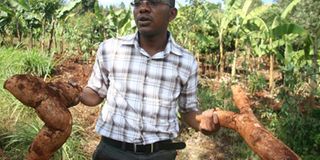Idea turns village into cassava hub

Michael Murigi with cassava harvested from their farm in Murang’a. PHOTO | JENNIFER MUIRURI
What you need to know:
- Lillian Jeptanui, a crop scientist from Egerton University says many Kenyans shun cassava.
- “Cassava is drought-resistant and a good alternative to maize. However, one should grow good varieties that are not attacked by cassava diseases or cyanide.”
Most farms in the larger Murang’a County teem with bananas, potatoes and tomatoes.
These crops are grown widely because there is ready market in Nairobi, Nyeri and Kiambu.
But in Muthithi, a location in the county, things are different. Here, many farmers have given the three crops a wide berth.
Acres upon acres of cassava resplendent in their green canopy colours this sprawling village in the Yatta Plateau, which receives minimum rainfall.
“It started just as an idea but now it is growing into an industry,” Michael Murigi, 24, the brainchild behind this change, told Seeds of Gold in his farm this week.
Having seen his parents and other villagers grow different crops with little success, Murigi, a Master of Economics student at the University of Nairobi, swore to change things.
“I had learned at the university that cassava is a drought-resistant crop, and I realised that this is what we needed in Muthithi.”
But there was a problem, Murigi did not know where to get quality seeds and how to go about making farmers embrace the crop.
“In 2010 while at second year, I approached PathWays, an organisation which, at the time was paying my fees in campus, to assist with the cassava project. They liked my idea and leased two acres for Sh10,000 a year for me to grow the crop,” says Murigi.
It is these two acres that would become the source of the cuttings and a spring of hope to this sleepy village.
The farmer knew he could not go alone in the project and succeed. He reached out to his friends and together they formed Focus Wise Self Help Group.
“We were 15 members. Each one of us contributed Sh1,000 which we used to buy improved cassava variety nodes from Kenya Agricultural Research Institute (Kari).”
“After getting the cuttings, we cut them into three parts and planted a metre apart horizontally,” he adds.
The cuttings are sold in bunches of three at Sh10.
The group further raised money for the project online through a website called Global Giving.
“The good thing with cassava is that it does not require manure, pesticides, weeding, or watering. You plant and forget. Then come back after eight months to harvest,” he says.
Murigi, however, thinks that using seeds for propagation take long to mature unlike the stems. Farmers are better off planting the stems which are cost-effective.
NUMBERS HAVE GROWN
From the cassava they planted, the group harvested cuttings which they gave various farmers for planting.
“We also taught them how to plant the crops as we had learned all that from Kari. The group would visit villages in the location and go to farmers’ field days to beseech them to grow cassava.”
However, few farmers bought the idea at first because cassava was a new crop.
The numbers have in the last four years, though, grown to 5,000 farmers not only in Muthithi, but also in neighbouring Kamahuha in Maragua.
“From the two acres, we can make about Sh500,000 a year by selling tubers and cuttings.”
With cassava, Murigi notes one can harvest from the leaves to the roots.
The leaves can be eaten as vegetables because they are rich in proteins, vitamins and minerals.
“We sell the leaves to Nigerians and Congolese nationals in Nairobi. They come here and buy in bulk at Sh10 a kilo. Few Kenyans, though, eat them. But the leaves are also good fodder for cows and goats.”
Isaac Kimemia is among young farmers in Muthithi who have embraced cassava growing.
The 22-year-old plants the crops on his parent’s farm.
“I grow them on an acre and harvest about 20 sacks after every seven months. Each sack is about 80kg and I sell a kilo at Sh20.”
SUBSTITUTE FOR MAIZE
The cassava “revolution” has seen Murigi’s two-acre demonstration farm visited by Ms Cindy McCain, the wife of US Senator and 2008 Republican presidential nominee John McCain.
She visited the farm in 2012 to see how indigenous crops were mitigating food insecurity in Kenya.
“Cassava can be used as a substitute of maize. We normally make flour and sell at Sh150 to Sh200 a kilo,” says Murigi.
In addition, cassava can also be used to make alcohol on large-scale. “Ethanol is produced by fermenting and distilling cassava.” Farmers should, however, beware of cyanide.
“High cyanide level is poisonous. It kills animals and people that is why it is important to buy certified seeds.”
Lillian Jeptanui, a crop scientist from Egerton University says many Kenyans shun cassava because it is considered a traditional crop and few understand how they can benefit from it.
“Cassava is drought-resistant and a good alternative to maize. However, one should grow good varieties that are not attacked by cassava diseases or cyanide.”
With countries such as Nigeria having begun commercialising cassava bread, the fortunes for this plant initially labelled the poor man’s crop, can only be brighter.





